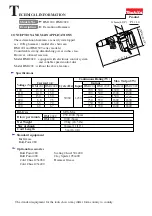
Page 60
EPS Stromversorgung GmbH
Alter Postweg 101 • 86159 Augsburg
Germany
PSI 9000 3U Series
Fon: +49 821 / 570451-0
Fax: +49 821 / 570451-25
►
How to start and stop a function
1.
The function can be started either by tapping
or pushing the “On/Off” button, if the DC output is
currently switched off. The function then starts immediately. In case START is used while the DC output is
still switched off, the DC output will be switched on automatically.
During the progress of the functions
sine wave, rectangular wave, triangular wave, trapezoi-
dal wave
or
ramp
only the actual values of U, I and P are displayed
.
2.
The function can be
stop
ped either by tapping
or operating the “On/Off” button. However, there
is a difference:
a) The
key stops only the function, the DC output
remains ON
with the static values.
b) The “On/Off“ button stops the function and switches off the DC output.
A device alarm such as overvoltage, overheating or power failure stops the function progress
automatically and the DC output is switched off.
3.9.5 Sine wave function
The following parameters can be configured for a sine wave function:
Value
Range
Description
I(A), U(A)
0...(Nominal value - (Off)) of U, I A = Amplitude of the signal to be generated
I(Off), U(Off) (A)...(Nominal value - (A)) of U, I Off = Offset, based on the zero point of the mathematic sine
curve, may not be smaller than the amplitude.
f (1/t)
1...1000 Hz
Static frequency of the signal to be generated
Schematic diagram:
Application and result:
O
ffs
et
A
m
pli
tude
t
A
f
A
m
plit
ude
A normal sine wave signal is generated and applied to
the selected set value, e.g. voltage (U). At a constant
load resistance, the output voltage and thus also the
output current will follow a sine wave.
For calculating the maximum power output the amplitude
and offset values for the current have to be added.
Example: an output voltage of 100 V is set together with
sin(I) with an amplitude of 30 A and an offset of 50 A.
The resulting maximum power output is then achieved
at the highest point of the sine wave and is (30 A + 50
A) * 100 V = 8000 W.
3.9.6 Triangular function
The following parameters can be configured for a triangular wave function:
Value
Range
Description
I(A), U(A)
0...(Nominal value - (Off)) of U, I
A = Amplitude of the signal to be generated
I(Off), U(Off) 0...(Nominal value - (A)) of U, I
Off = Offset, based on the foot of the triangular wave
t1
0.1 ms...36000 s
Rising edge time Δt of the triangular wave signal
t2
0.1 ms...36000 s
Falling edge time Δt of the triangular wave signal
















































